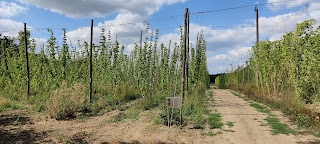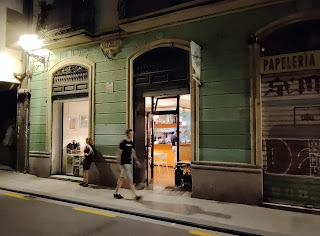It's the Pig's Ear beer festival in Hackney next week. I'm looking forward to it even more than usual this year, because if all goes according to plan, it’ll see a rare outing for cask beers from Walthamstow’s Signature Brew – and an even rarer UK one for cask beers from America's famed Dogfish Head. And they’ll be the same beers...
At least, that was one of the stories I heard when I was over at Signature last month for an event billed as “The intertwined history of punk rock and craft beer”.
I have to confess that, when I first saw that headline, I didn’t get it. I was around in 1977, and I’m pretty damn sure there weren’t any punks necking single-hop pale ales and kettle sours – and there definitely wasn’t any Punk IPA!
 |
| Sams M (left) and C (right) |
That first collaboration is an updated version of a beer Dogfish brewed several years ago called Piercing Pils. This playful take on the Central European classic – Dogfish styles it a Czech Pils, but it has definite Germanic notes – features both pear juice and pear tea alongside the noble hops. The pear juice adds both fermentable sugars, a fruity flavour and an intriguing, faintly Belgian estery note, while the tea melds with and builds the spicy character of the hops.
It’s a very nice and very well-made beer – but why add flavours to a classic like Pils? “Since the craft beer revolution, brewers have been putting all sorts of crazy stuff into ales, but usually not lagers,” laughed Sam C. “With lager, there’s nothing to hide behind, so not too often do people fuck with lager – but we do!”
That ‘nowhere to hide faults’ aspect is why some modern ale brewers make lager, to show they really can brew, but as Sam M pointed out, that’s not relevant here. “The kit here [at the Walthamstow brewery] is already set up for lager,” he explained. “A lot of the work we did here was to bring our Studio Lager in-house.”
 |
| Beer and band punks on stage together |
But with all this industry going on, where’s the punk angle? To discuss it, the two Sams were joined on the Signature brewhouse stage by Matt Reynolds of modern hardcore punk duo Haggard Cat, and Jon Langford of 1970s punk band The Mekons – roadies had been busy all afternoon setting up the stage for the two bands to play later that evening.
For all four of them, it’s a shared concept – a rejection of the mainstream and a determination to do your own thing. As Langford explained, while 1970s London punk was very shock-orientated, the north-east punk scene that The Mekons came out of was very different. “We thought it was all about you make your own entertainment, for us in The Mekons it was all do-it-yourself,” he said.
Sam C said that American craft brewing, fired up by President Jimmy Carter’s 1978 legalisation of homebrewing, was driven by a similar rejection of the mainstream. “The homebrewing movement was a punk movement,” he declared. Dogfish Head may have been founded in 1995 – Calagione calls it “a second-generation craft brewery” – but it still started out as him and two friends brewing in a kitchen.
 |
| Burnished amber in a glass |
So, a Punk Pear Pils then? Well, maybe – it’ll certainly have the guardians of the Einheitsgebot (the Law of Sameness) shaking their heads. And according to Signature Brew’s other co-founder Tom Bott, it’s not the only thing that Sam C and the Dogfish crew were in town for – the week after we spoke, they were due back at the brewery to start work on a collaboration Porter, to be brewed with Vietnamese pepper and maple syrup!
And that's where it got extra-interesting. Tom said they also plan to cask some of both the Porter and the Piercing Pils. Signature started doing cask beers about a year ago – initially just versions of its Roadie and Backstage IPAs – but only for sale through two handpumps in the brewery taproom. Now, Tom said they’re also “thinking to let some casks out further afield,” with Pig’s Ear a likely early recipient.
Not just a Punk Pear Pils, then, but a Cask Punk Pear Pils. Now that’s my kind of DIY entertainment… See you at Pig's Ear!













































